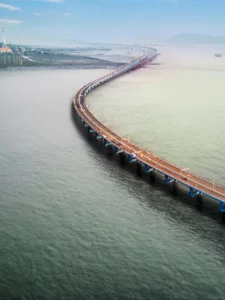Atal Setu Bridge: India’s Landmark Infrastructure Achievement
Atal Setu Bridge: India’s Landmark Infrastructure Achievement
The Atal Bihari Vajpayee Sewri-Nhava Sheva Atal Setu Bridge, more commonly known as Atal Setu Bridge, stands as a testament to India’s engineering prowess and commitment to infrastructure development. Spanning 21.8 kilometers, it includes a remarkable 16.5-kilometer sea bridge, now the longest in India and among the top 12 globally. This ambitious project was initiated to tackle the longstanding issue of traffic congestion between Mumbai and Navi Mumbai, providing a crucial link that promises to transform regional connectivity and economic opportunities.

A Vision Realized: Construction and Inauguration
The project’s journey began with the laying of its foundation stone in April 2018 and culminated in its inauguration on January 12, 2024, by Prime Minister Narendra Modi. The Atal Setu was envisioned not just as a means to ease vehicular movement but also to incorporate advanced engineering solutions while adhering to stringent environmental standards. Its construction was a complex endeavor, overcoming logistical challenges and environmental considerations to deliver a structure that balances functionality with sustainability.
Vadhavan Port: India’s Future Maritime Marvel
Engineering Marvel: Features and Design
Atal Setu boasts six lanes, including emergency exit lanes, capable of accommodating up to 70,000 vehicles daily. It integrates innovative features such as orthotropic decks, which enable longer spans without additional support pillars, thus minimizing disruption to maritime traffic in Thane Creek. The project utilized massive quantities of materials, including 165,000 tonnes of reinforcement steel, 96,250 tonnes of structural steel, and 830,000 cubic meters of concrete, reflecting its scale and ambition.
Impact and Benefits
Beyond its impressive dimensions, Atal Setu promises substantial benefits for the Mumbai Metropolitan Region and beyond. It aims to significantly reduce travel time, enhance regional connectivity, and stimulate economic growth by facilitating smoother movement of goods and people between Mumbai and Navi Mumbai. The project’s completion marks a milestone in India’s infrastructure development, underscoring the nation’s capacity to undertake and deliver complex projects of global significance.
Unlocking the NEET UG 2024 Answer Key: Your Ultimate Guide
Looking Ahead: Legacy and Future Prospects
As India continues to invest in its infrastructure, projects like Atal Setu exemplify the nation’s commitment to bridging urban divides and fostering sustainable development. The bridge stands not only as a symbol of connectivity but also as a testament to the collaborative efforts of engineers, planners, and policymakers who made its realization possible. Moving forward, it is poised to serve as a vital lifeline, supporting regional growth and positioning India as a leader in infrastructure innovation on the global stage.

Conclusion
In conclusion, Atal Setu represents a landmark achievement in India’s infrastructure landscape, blending advanced engineering with environmental stewardship to deliver a transformative asset for the Mumbai Metropolitan Region. Its completion not only addresses longstanding transport challenges but also sets a precedent for future infrastructure endeavors in the country. With its inauguration, Atal Setu stands ready to redefine connectivity, efficiency, and economic vitality for generations to come.















Post Comment